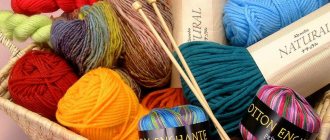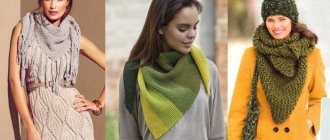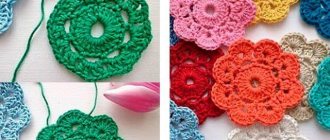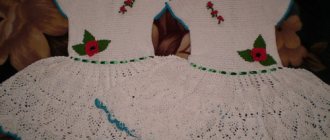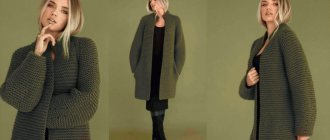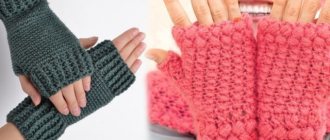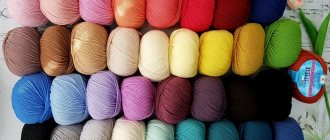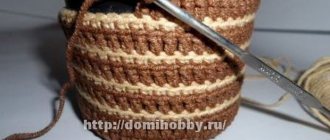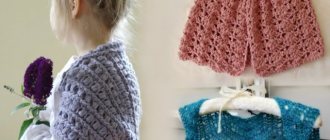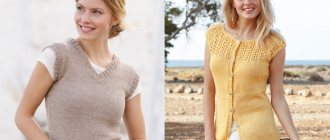- 30077
- 13-10-2020
- Author: Mysekret Team
- 0
Knitted items will help create coziness and a feeling of warmth in the house, and crocheted tablecloths will create a spiritual mood in the kitchen. Many people associate such products with mothers and grandmothers - that is, with their home, warmth and care. Perhaps it's time to create a similar feeling for your loved ones? Crochet patterns and step-by-step descriptions of the work will help with this. And to avoid endless searches for the necessary diagrams and descriptions in magazines and on the Internet, you will need this article.
Selection of material and tools
In most cases, cotton yarn with a strong twist is used to knit tablecloths. This gives the fabric a denser structure and creates a starched look. If threads with medium or weak twist were used, then after finishing the work it is advisable to starch such a tablecloth so that it can keep its shape and form smooth, beautiful folds.
You can also use acetate or silk yarn for special occasions. When knitting tablecloths from silk or acetate threads, it is recommended to do the work in one piece due to the strong flowability of such yarn.
If the product is still intended to be made from motifs, then you should choose a reliable way to fix the ends of the thread. This is due to repeated washing of the finished fabric. Don’t forget about carefully choosing a knitting tool.
Currently, there are many hooks of various lengths, thicknesses and compositions:
- plastic, 27
- wooden,
- aluminum,
- metal,
- made of stainless steel.
From this list, according to experienced craftswomen, you should choose short (regular) hooks, since long ones are intended for Tunisian knitting and metal (stainless steel) are solid with a small notch on the handle. They, unlike others, do not stain the yarn and glide easily along the thread. You should also pay attention to the hook head itself.
It should not be too sharp so as not to get hurt and experience pain and inconvenience when working. But she shouldn’t be too stupid either, as it will be difficult for her to get into the loop.
It is advisable to try several hook options before starting knitting and choose the optimal and most convenient one.
How to calculate the size of a tablecloth?
Due to the purpose of a certain type of tablecloth, they have their own sizes.
So they are designed for:
- everyday use;
- festive feast;
- buffet table.
For the first option, the dimensions of the tablecloth should correspond to the dimensions of the table and hang from its sides at a distance of 15-20 cm. This does not prevent visitors from feeling comfortable at it. The second option provides tablecloth sizes that exceed the parameters of the tabletop by 20-30 cm.
For the third option, the length and width of the tablecloth is preferable, exceeding the dimensions of the table by more than 30 cm. The final limits are unlimited.
Classic square tablecloth
Crocheting a tablecloth, the diagrams and description of which are offered nearby, is a technique made from square motifs. This is what is used in most cases to create elegant and extraordinary products.
This model is suitable for use on both square and round tables. It is advisable to make it from cotton yarn using a hook number 2-3. The color scheme may vary depending on the interior and the utensils and decor used. But the most traditional color is white.
By knitting motifs, their connection can be done both during the work process and after its completion. But, according to experienced craftswomen, the first method is more convenient and practical. When the tablecloth is knitted, it is advisable to starch and steam it. The next model also features a square tablecloth made from large motifs of the same name, but applied to a round table.
The main technique used in knitting this model is fillet. But it is carried out in combination with light openwork. In order not to get lost and not to disturb the structure of the pattern, it is necessary to clearly follow its pattern, especially when performing reverse rows.
The coupling of motifs is carried out during knitting of the outer row.
After completing the main fabric, you should decorate its edges with binding according to the presented diagram. It is carried out along the perimeter of the tablecloth in straight and reverse short rows using the same technique. The finished product must be wet-heat treated.
Knitted tablecloth from large motifs
The tablecloth has a hexagon shape, dimensions 134cm by 102cm.
We will need:
- threads, cotton – 800g;
- hook No. 1.5.
Description
The knitted tablecloth consists of 24 fragments, each of which measures 20cm by 22cm. We knit the fragments according to the instructions in the diagram with 1p. 16 rub.
For beginners, here is a breakdown of the notation.
We start knitting each fragment with a ring of 8 VP. Then we perform rapports. On сх. one of them is shown, in total you need to complete 8 rapports. Rows on сх. marked with numbers, the number of VPs in them is written under the arches. Knitting each r. We finish with a closing connecting column. Climbing to the new river We perform VP, replacing the column.
When knitting the last p. fragment we connect it with those already knitted. The connection points in the diagram are indicated by arrows. We assemble the main canvas according to the diagram.
Tie the edge in a circle. Border on сх. marked in brown - from 17th p.m. on the 22nd r. We knit picot from 7 VP.
Wash and starch the finished item. Stretch on a horizontal surface, securing to the required dimensions, and dry. Can be ironed while wet from inside out.
Simple rectangular tablecloth
To make a tablecloth of the required size, you should initially determine for which table it will be used and calculate the required dimensions. To do this, measure the length and width of the tabletop and add a certain (as intended) allowance.
After this, it is recommended to run the selected sample and compare its parameters with the obtained calculations. Minor deviations from the required measurements when knitting tablecloths are allowed.
Crochet a rectangular tablecloth. Knitting pattern.
It is advisable to use cotton-containing yarn and a hook of the corresponding number for this model. It ranges from No. 1.5 to No. 3. The connection of motives is carried out according to the presented diagram. These motifs do not need final tying.
The crochet tablecloth patterns and descriptions that follow can be applied to a more casual setting. This tablecloth is also made using the technique of individual motifs. They are round in structure, but due to the elongated loops from the chain they create a square effect and serve as a place for connecting motifs.
It is advisable to use cotton yarn, but a small amount of viscose or synthetic fibers is also possible. For a denser fabric, you can use a hook with a thickness almost identical to the thread. If you want to get a tablecloth with a less dense structure, the hook number should be an order of magnitude thicker.
When initially calculating the length and width of the required product, do not forget about the binding, the width of which can significantly affect the final dimensions. If the number of complete motifs differs slightly from the calculations, they can also be adjusted using strapping.
Decorating the edge of the tablecloth with a binding is carried out after linking all the motifs into a single fabric by knitting along its perimeter only in straight rows. Properly connect at the end of the row to avoid additional loops or large spaces. If the motifs are tightly knitted, such a tablecloth can not be starched, but can be limited to damp-heat treatment.
A variant of an elegant tablecloth for tea drinking is presented in the following figure. It is made in one piece with a simple geometric pattern.
To knit this model, you can use thin cotton threads, as well as viscose or silk. Hook No. 1-2 is preferred. Close attention when working on this model is required at the beginning of the process. Following the presented pattern exactly, you need to knit several repeats in height. After which the pattern will then tell you how to knit.
When calculating the number of repeats of the length and width of the tablecloth, you should pay attention to the symmetry of the longitudinal and transverse sections with each other. This geometric pattern can be used to knit a square tablecloth, as well as use it for a round table.
After finishing knitting the main fabric, it is advisable to decorate its edges with openwork binding. It can be either medium or wide in size. Its choice is made individually at will.
The color definition of the tablecloth also depends on the interior of the room and the cutlery used in the ceremony. If it is made in the same tone as the dishes, it will create the integrity of the composition of the entire table with the surrounding pieces of furniture. If tied in a contrasting color, it will emphasize the elegance and beauty of the table service. It is recommended to starch and iron the finished tablecloth.
Patterns for knitting rectangular tablecloths from our website
Rectangular tablecloth made from motifs from Irina Georgievna
I really want to meet all my friends more often, and set the rectangular table beautifully. So that everyone would be comfortable and wonderful, and everything on the table would be lovely. And to make it even more elegant, put this tablecloth on the table: made of motifs, apricot color, 135*190.
Read more, description...
Crochet rectangular tablecloth
The model consists of square motifs. Unfortunately, I couldn't find the diagram. Size 1.2 m by 1 m. Yarn “Lily”, 100% cotton, hook 1.5. Description of work: 1st row - in amigurumi ring 6 in.p. (3 for lifting and 3 according to the pattern), dc, 3 ch, dc, 3 ch, dc, 3 ch, 4 in total
Read more description...
Rectangular tablecloth Chamomile field
You walk into the kitchen in the morning, and there are daisies “looking” and “smiling”! How they cheer up with a cup of coffee and a piece of cheese with lemon! Knit the same one for yourself, girls, you won’t regret it!!! Cotton threads, hook 2.0. Daisy motif, rectangular size 200*300. The edging is knitted using the Bruges knitting technique. The work of Irina Georgievna.
Crochet pattern for a rectangular tablecloth
Rectangular crocheted viscose tablecloth
From 100% viscose, we got this rectangular tablecloth. It took me a very long time to knit, with a break of 2 years, but now she is ready and makes me happy. It took 1300 g of yarn, 2.5 hook. I took the square motif pattern from the Internet, but how
Read more description...
Crochet rectangular tablecloth Elegance
A rectangular tablecloth called Elegance. This is where my passion began. Knitted from Dandy Camtex yarn. (330 m in 50 g), edge 1.5 mm Can be laid directly on the table or on a fabric base. And this is how she
Read more description...
Rectangular tablecloth in the fillet technique Autumn blues
Rectangular tablecloth in the “Autumn Blues” fillet technique. Knitted from cotton “Loop” of Troitskaya f-ki hook 1 mm size 1.5 by 2.5 m. Yarn consumption 500 g. What is a cozy home? A home you want to come to again and again? For me it is a symbol of home comfort
Read more description...
Crochet rectangular napkin
Beige napkin. Made from "Chamomile" yarn. 320 m / 75 g. Consumption 4 1/2 skeins. The size of the finished work is 120 x 68 cm, the size of the motif is 17 x 17 cm. A total of 18 motifs are connected,
Read more description...
Crochet tablecloth rectangular Tea rose
The work of Lyudmila Petrova. The tablecloth, which received a diploma in the competition on Osinka, is called “Tea Rose”. Was given to a friend as a housewarming gift. Size 156x210, Table size 80x130. The tablecloth is made using the loin knitting technique, yarn “Dandy” Kamtex, color “champagne” mercerized long-fiber
Read more description...
Crocheted rectangular tablecloth for the dining table
Crochet tablecloth for the dining table. I used #10 bobbin thread for the tablecloth. It took about 5 thousand meters. Clover hook 0.9. Individual squares were knitted (48 in total), which were joined in the last row according to the description. After connecting all the squares
Read more description...
Beautiful rectangular crocheted tablecloth, description and diagram
And here is my favorite tablecloth. Knitted from “Lily” (Kirov plant). The thread is just right for tablecloths. I didn’t have to starch it; in my opinion, it holds its shape well. The colors are beige and milky. I am attaching the diagram, but as for the brushes -
Read more description...
Rectangular tablecloth made of crochet motifs
Tablecloth for the dining table. Made with crochet number 2 from 100% mercerized cotton “Soso” 600 gr. A ball of thread lay there for a long time and a friend suggested this idea. She is simply afraid of the snow-white tablecloth, afraid that she will not be able to wash off what appears
Read more description...
Rectangular tablecloth from Valentina Litvinova
The square tablecloth is crocheted No. 1.0 from motifs. The motifs are connected to each other along the last row. Dimensions 130 cm by 131 cm. Yarn 100% cotton. Looks good on both square and round tables. The tablecloth consists
Read more description...
Crocheted rectangular tablecloth from Tatyana Ivanovna
A large elegant tablecloth on a rectangular table. The tablecloth was long-awaited, I really wanted to knit a rectangular one, otherwise everything is round and round. I didn’t find it particularly difficult, just knit and knit. But you need a lot of time and patience. Crocheted tablecloth
Read more…
Crocheted rectangular tablecloth with “pineapples”
The tablecloth is white. The size of the finished product is 152 cm. Knitted from the center in a circle. Natural cotton yarn 100% "KAMTEX", consumption of 6 skeins - 400m/100g. Difficulty is average. The diagram is attached. There are deviations from the finished work
Read more…
Knitted rectangular tablecloth from Valentina Litvinova
The tablecloth is rectangular. The tablecloth is knitted from motifs. The motifs are connected to each other along the last row. Dimensions 130 cm by 140 cm. Yarn 100% cotton (100g - 800 m). A tablecloth can be used to cover both a rectangular and a round table. Scheme
Read more…
Crochet rectangular tablecloth, description and diagram
The tablecloth is rectangular. Crocheted. Will decorate both rectangular and round tables. Dimensions 60 cm by 120 cm. A very beautiful pattern in which pineapples from convex cones predominate. Emphasizes her expressiveness and beauty. Yarn 100% cotton.
Read more…
Rectangular tablecloth using fillet technique
A napkin is a handmade tablecloth. Hook technique. Yarn composition: cotton (100g/425m). White color. Size 100x100cm. Looks good in any interior. Tablecloth knitting pattern:
Read more…
Openwork
Crocheting a tablecloth, the patterns and description of which are presented below, requires certain experience and skills.
The yarn used is mercerized cotton or with the addition of viscose. Hooks No. 1-2 respectively.
This model contains 2 knitting techniques: regular and fillet. It is made of a continuous canvas and presents a geometric pattern on which squares with a fillet composition are located.
When determining the size of the tablecloth, you need to measure the tabletop and add allowances of the required length. Then, based on the knitted pattern, calculate the number of cm per 1 complete pattern repeat. Next, compare the required dimensions of the tablecloth with the length and width of the completed sample and set the number of whole repeats included in the required parameters.
Before starting work, it is recommended to study the knitting patterns very carefully, since their implementation requires considerable experience. Having thoroughly analyzed each of their elements, you can begin to work.
When performing reverse (purl) rows, the pattern should be read from left to right.
After finishing the knitting process, it is advisable to decorate the tablecloth with a thin binding consisting of 1 row of single crochets and 1 row of “crawfish step”. This will prevent the edges of the canvas from further deformation. Carry out a wet-heat treatment with the finished tablecloth.
Crocheted tablecloth for a round table pattern
These adorable hexagons with a floral design in the middle make more than just round tablecloths. They can also be used for table runners or even large tablecloths with different color combinations - your guests will be delighted when they see the table set.
Size: approx. 76 x 84 cm.
You will need:
- yarn (100% cotton; 85 m/50 g) -300 g natural white, 150 g gray, 100 g pink = 1st decorative color and 50 g blue = 2nd decorative color;
- hook number 6.
Hexagon:
Use a decorative thread to make a chain of 5 sts. p. and close into a ring using 1 connection. Art. Continue work according to pattern in circular rows. Start each round row with the initial ch. acc. diagram and complete 1 connection. Art. to the last initial ch. or in the 1st loop of the circular row. Perform the 1st-5th circular rows 1 time, while performing the initial row and the 1st + 2nd circular rows with a thread of a decorative color. 3rd circular row - gray thread. 4th + 5th circular rows - with white thread. When changing color, secure the new thread with 1 connection. Art. acc. scheme
Knitting density:
hexagon = 12 cm from edge to edge or 13 cm from top to top; These dimensions were obtained by measuring the model. Description of work: make 25 hexagons with pink and 12 hexagons with blue thread.
Assembly:
arrange the hexagons according to pattern and from the wrong side connect with white thread st. b/n. At the same time, insert the hook only behind the front walls of the edge loops.
Up
Festive tablecloth
For special special occasions, you can make a tablecloth, the model of which is presented below.
It is made of snow-white mercerized cotton with crochet size 2.5-3. Consisting of square motifs, when connected to create another additional pattern, it impresses with its richness and grandeur.
It can be used on both a rectangular and oval table. When calculating the length and width of the tablecloth, slight deviations are allowed in order to achieve a whole number of complete pattern motifs. It is better to couple the elements while knitting the outermost row.
After completing the main fabric, you should tie the edge of the tablecloth around the entire perimeter. For decoration, it is advisable to use a border of a small pattern of the same type so that the focus of attention from the canvas itself is not lost.
Tablecloth made of melange yarn
Dimensions: 96 cm by 60 cm (border not included).
We will need:
- melange yarn in pink colors – 500g;
- white yarn, 100% cotton, 100g per 565m – 200g;
- hook No. 1.5.
Scheme
Density: large motif has Ø12cm, small motif has Ø2cm, border height 7cm.
Description
Large fragments
We start the large element with a chain of 12 VPs. We close it in a ring, knit 3 VP lifts and then perform circular knitting according to cx. 1. Starting a row with 3 lifting VPs (replacing 1 Sts), we end it with Sts in the 3rd lifting VPs. And if the beginning of the row is performed with 1 VP of lifting (= 1 StBN), then its completion SST should be in this VP. The diagram shows all the rows; further knitting of fragments is carried out by analogy.
We connect the fragments to each other when knitting the edges, in the last row.
The connection points are indicated for beginners by arrows in cx. We knit 36 fragments with our own hands using melange threads and connect them to each other. Next, knit 28 fragments with your own hands using white threads. We place them in a circle, connecting them to each other and attaching them to the melange fragments.
Round tablecloth
For needlewomen who have at least once knitted round napkins, it will not be difficult for them to make a tablecloth. It consists of the same patterns, but is larger in size.
It can be made from various types of yarn. Thickness can also range from thin to medium. It is advisable to use 1-2 more hook numbers to make the fabric look more openwork. When making a pattern, you should correctly connect the loops at the end of the row with the beginning in order to avoid distortion of the ornament and the size of the inter-loop space.
Also, the diameter of the tabletop plays an important role when knitting a round tablecloth. Since when the tablecloth reaches the edge of the table, it can be made further in a circle, maintaining evenness in relation to its middle. But there is an option when the tablecloth from the end of the tabletop can be rounded down and have a convex structure that matches the shape of the table.
The choice of option depends on the purpose of the tablecloth:
- In the first case, the product is used mainly as decoration for a buffet table and is laid on top of a larger fabric tablecloth. The color scheme in this situation should correspond to the base material. The color of the knitted tablecloth can be chosen in the same range as the main one, but a tone or two darker or lighter. It is also possible to make it in a contrasting color, but it must fit into the surrounding interior. In most cases, for a striking difference from the main tablecloth, white is chosen.
- In the second case, a knitted tablecloth can be used for everyday use and have small allowances. It is advisable to lay it without any extraneous auxiliary objects.
When knitting a tablecloth with a flat surface, it is necessary to add stitches evenly so that unnecessary bulges or tension do not occur. It is recommended to decorate the edge of the finished tablecloth with a binding that matches the selected pattern. If the central part of the product has the appearance of a flower or an uneven openwork pattern, then it is advisable to use a calmer and more uniform border for the binding.
If the middle of the tablecloth is the same pattern, knitted in a circle, then the cut can be decorated with an interesting openwork wide edging or small floral and round motifs. The combination of patterns in such models will be ideal. After finishing knitting, wet and heat treat the finished tablecloth.
Thick tablecloth made of colored motifs
Dimensions: 76cm by 84cm.
We will need:
- threads, 100% cotton, 50g per 85m, white – 300g;
- the same gray threads – 150g;
- the same pink threads – 100g;
- the same blue threads – 50g;
- hook No.6.
Scheme
We knit the motifs with our own hands according to the pattern.
Density: the hexagon is 12 cm along the edges, 13 cm at the vertices.
Description
When knitting fragments, consider how many elements you need to get with a blue center, and how many with a pink center. There should be 25 in total with a pink center, 12 with a blue center.
We start with a chain of %VP. We close it in the SST ring. Next, we perform circular knitting according to cx. Every r. we start with VP and complete the SST in the outermost initial VP or in the 1st paragraph of the circle. R.
We knit once with 1p. 5 rubles each, with the 1st and 2nd rows knitted in blue (pink), 3rd row. - gray yarn, 4th and 5th rows - white yarn. Connecting a new thread we make 1 connection. stlb.
Assembly
We lay out the fragments with the wrong side up according to the pattern and sew them together with white threads. When sewing, insert the hook only behind the front walls of the edge loops.
Oval tablecloth
Crocheting a tablecloth, the patterns and description of which are presented below, is an analogy for making a napkin of the same name. Therefore, when choosing a base, you can use any oval napkin pattern. By complementing it with the same pattern or adding something else, you can create an exclusive tablecloth.
When knitting it, you can use different types of yarn: from light and thin cotton to silk, acetate of medium thickness and twist. Hook numbers can also range from 1 to 3.
The difference between this type of product and the round one is that the distribution of additional loops is not carried out evenly, but only in four areas located at the conventional corners of the tablecloth. This option of adding is used when knitting a whole fabric.
If the tablecloth consists of different types of motifs, then their connection at the turning points will also differ from the connections on the sides. It will be more rare. In this regard, it is necessary to carefully monitor the knitting pattern (if it is available) or record on paper the method of joining the motifs in these areas in order to avoid mistakes in further connection.
Depending on the pattern used, you should also determine whether there is a binding or not. After completing the knitting, it is recommended to steam the finished tablecloth.
Crocheted oval tablecloths from foreign magazines: step-by-step instructions
Foreign crochet magazines contain a huge number of patterns for beautiful tablecloths.
The only drawback of such visual guides is that for those who do not speak Polish, English or Chinese, it is almost impossible to knit any product. More experienced needlewomen who are familiar with patterns can, by looking at the images shown in magazines, knit something more or less similar. It is better for beginners to learn from manuals in Russian.
The most popular patterns that are published in foreign magazines are products knitted using the fillet technique. The “loin” looks best in cotton crocheted No. 1, 25.
Step by step description:
- Work begins according to the scheme from the middle to the edges.
- The diagram shows only the fourth part; the remaining elements must be knitted in a mirror image.
- The length of the product can be increased by adding repeats.
Loin tablecloth
Crocheting curtains, tablecloths, scarves can be done on the basis of a regular grid. One of the schemes with a description is presented in this section.
Basically, for knitting tablecloths using the fillet technique, thin cotton yarn is used, or with the addition of a small amount of viscose fiber. Hooks must correspond to the thickness of the thread and be within the range No. 0.75-2.
The accent of this type of knitting is a floral or any other composition created in the process of filling the cells of a regular grid with double crochets. The technique itself is not at all complicated. Only 2 types of symbols are involved in it: double crochets and air loops.
The mesh is knitted by constantly alternating one and the other loops, and the cells with the pattern are filled with two single crochets.
When knitting 2 columns of a pattern in squares, they should be made with a single vertex so as not to disturb the structure of the mesh itself. When subsequently working with the same cells, crochet punctures must be made into adjacent loops, and not into one. Simultaneously with the central ornament, finishing is done along the edge of the tablecloth, also located on the mesh.
If desired, you can decorate the cut with fixing rows of single crochets or a row of “crawfish step”. This tablecloth model needs starching.
How to crochet a tablecloth on an oval table: description and diagrams
Crocheting requires the presence of some kind of pattern on the fabric.
The simplest and most common pattern for tablecloths, napkins or kitchen curtains is considered to be “pineapple”. There are many variations of this beautiful and interesting pattern; there are no specific requirements for its implementation. The main thing is that the final pattern resembles this exotic fruit in shape. To knit a tablecloth with a pineapple pattern you will need:
- cotton yarn – 1 kg;
- fabric markers;
- hook number 1, 75.
Check out the detailed description of the work progress:
- Knitting an oval tablecloth begins with its central part. The first 100 chain stitches are picked up with a crochet hook.
- Make 4 lifting air loops to move to a new row and begin to knit a bias mesh according to pattern No. 1.
- The row is closed with a joint column knitted into the first air loop of the cast-on edge.
- The next stages of knitting are performed according to pattern No. 1, on which the knitting direction is indicated by arrows.
- Looking at Figure 1, the knitting is divided into side and central parts, and markers are installed.
- Guided by scheme No. 2, a pattern is knitted, the repeats of which are shifted in a “chessboard” pattern relative to each other.
- Guided by diagram No. 3, the sides are knitted.
- Repeat the height from rows 10 to 28 four times and close the knitting.
Advice! The finished tablecloth is washed by hand and dried on a hard horizontal surface. To better keep the product in shape, you can starch it.
In addition to “pineapples,” a product with a floral pattern in the middle and a border on the sides will look great on an oval dining table. The product will look original and interesting if the border is made of white threads and the central part is blue.
To work you will need:
- blue cotton threads – 350 g;
- white cotton threads – 150 g;
- hook number 1.5.
Step-by-step description of the work:
- Knitting is done according to the pattern.
- You need to start by casting on 243 air loops with blue threads, of which 238 are the main ones, and the rest are for lifting.
- First row - one double crochet is inserted into every ninth chain stitch.
- Then 79 fillet knitting cells are knitted.
- The following rows are knitted in forward and reverse directions using the fillet technique up to row 67.
- Work on the border begins by attaching a white thread.
- It is used to knit a border around the entire perimeter of the product.
- 10 rows are knitted with white thread, each of which is completed with a connecting stitch.
Motif tablecloth
An option for an elegant and very delicate tablecloth is the model presented below. It is made of round motifs, knitting which is not difficult.
The yarn used is thin cotton or cotton thread containing viscose. Its presence in the composition provides the finished product with softness and good drape. The optimal hook numbers are 1-2. This tablecloth model is universal. It can be knitted on a round, square or rectangular table. This is accomplished by varying the arrangement of motifs.
A more effective way to connect elements is during work. It provides the tablecloth with practicality and durability with frequent use. The most advantageous color scheme in this model is white. It creates the most solemn combination with any plain color of the main tablecloth. But variations in this regard are possible according to desire and individual approach.
After completing the tablecloth, it is recommended to decorate its perimeter with a binding consisting of arcs of air loops, in the middle of which a pique is made. This will give the product greater elegance and airiness. At the end of the work, it is necessary to carry out wet-heat treatment with light starching.
How to knit a simple tablecloth on a rectangular table step by step
A very beautiful and very simple tablecloth with birds for a rectangular table. The model was made using a simple fillet mesh with a simple fabric pattern.
To work you will need:
- iris yarn approximately 200 g;
- hook number 0.85.
The size of the product will be 100 x 60 cm.
Stage: set . Crochet 366 chain stitches.
1st row: knit 1 dc in the 9th loop and so you get the first square, * 2 chain loops, double crochet in the 3rd and continue such squares until the end of the row. The work is done using the fillet knitting technique. Knit the completed squares of the pattern using double crochets.
Stage: border . Only 4 rows were used for tying and they are presented in the diagram.
Stage: drying. To get a flat and very even product, you need to wet a towel and spread the finished work, place the towel on top and wait until it dries completely. Then iron with an iron.
Recommendations for beginning needlewomen
To ensure that knitting brings pleasure and positive emotions from the first steps, you should follow a few simple recommendations:
- Use only high-quality yarn (smooth without sagging).
- Using the trial method, select the most convenient type of hook.
- After testing all possible options for positioning the hook in your hand, choose the most comfortable one.
- Learn the symbols of all types of loops and learn how to perform them correctly.
- Understand reading pattern diagrams.
- Start knitting with the simplest and most understandable ones.
- Gradually introduce more and more complex elements into the work.
Only by creating comfortable working conditions can the most positive results be achieved. To get moral satisfaction and pleasure from crocheting tablecloths, napkins and other beautiful things, it is enough to use the proposed patterns, follow their descriptions and adhere to the necessary and simple tips and recommendations.
